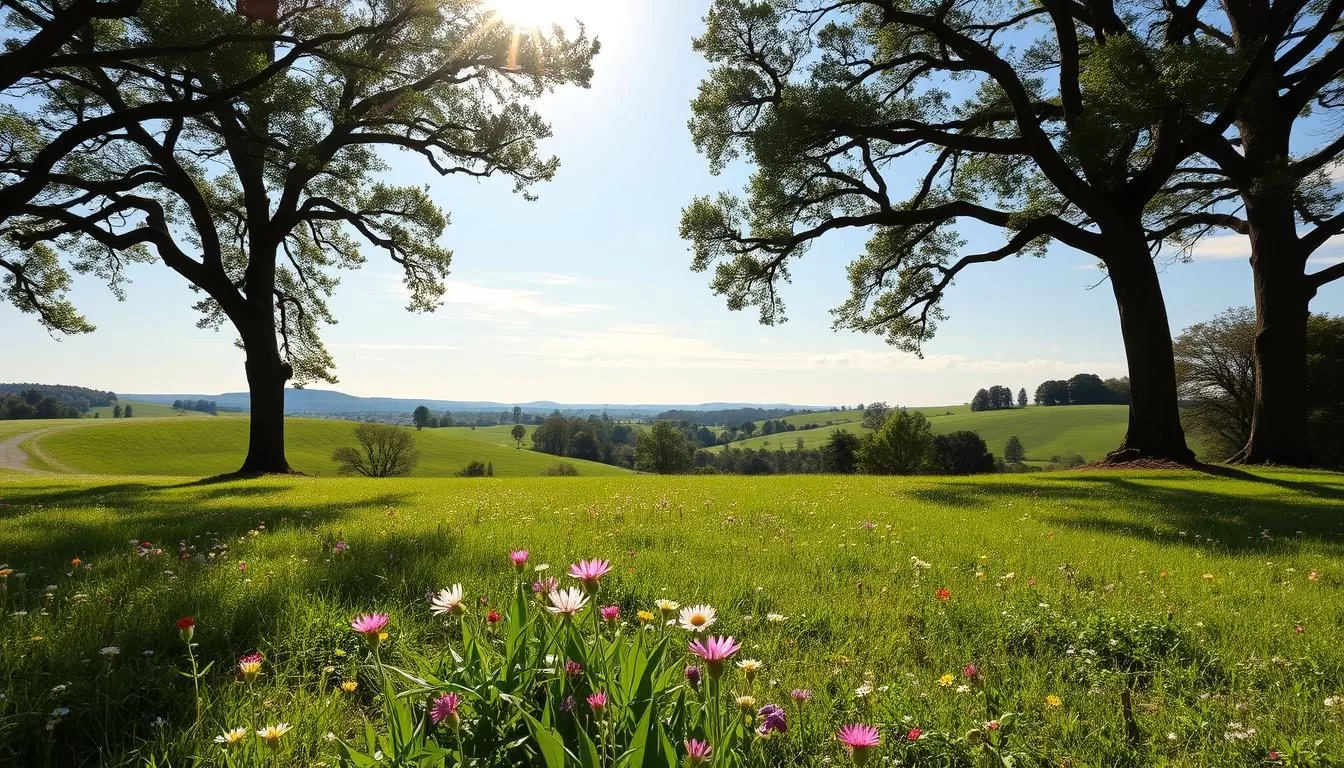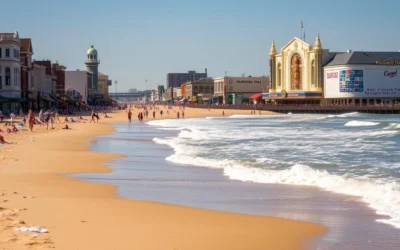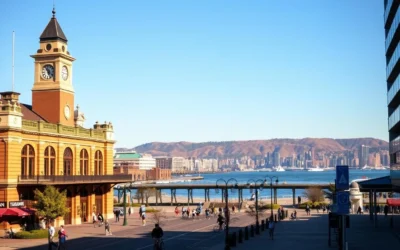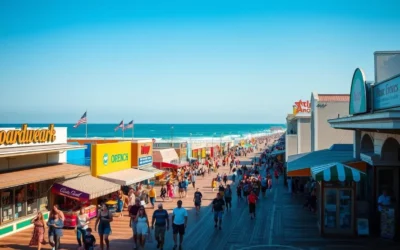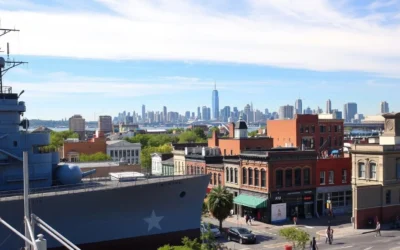Planning a trip to New Jersey can be a delightful experience, especially when you consider the weather. Located on the Atlantic coast, this Mid-Atlantic state experiences a climate that varies significantly throughout the year. To make the most of your visit, understanding the seasonal climate variations is crucial.
The spring season, from April to May, brings pleasant weather, with sunny days and blooming flowers, making it an ideal time to visit. The warmth continues through the summer, making it perfect for beach activities at the Jersey Shore. As the year progresses, the fall season offers a picturesque landscape with colorful foliage.
Understanding the weather patterns and seasonal variations will help you plan your activities and make the most of your trip to New Jersey. Whether you’re looking for a beach vacation or a hike, knowing what to expect will enhance your experience.
Understanding New Jersey’s Climate
Understanding the climate of New Jersey is crucial for planning a weather-savvy trip. The state’s climate is characterized by its distinct seasonal changes, influenced by its mid-Atlantic location.
Four Distinct Seasons in the Garden State
New Jersey, known as the Garden State, experiences four distinct seasons. You’ll find chilly winters and hot, humid summers, providing different travel experiences. Winters, especially from January to March, are very cold, with temperatures ranging between 25 and 35 degrees Fahrenheit.
Geographic Variations: Shore vs. Inland Weather
The Jersey Shore and inland areas experience different weather conditions due to New Jersey’s geographic variations. Coastal regions typically enjoy slightly milder temperatures in winter and cooling sea breezes in summer compared to the interior parts of the state.
Summer in New Jersey: Peak Season Experience
With the arrival of summer, New Jersey’s beaches, boardwalks, and outdoor spaces become the epicenter of activity and entertainment. The warmth of the season brings with it a plethora of experiences that cater to all ages and preferences.
June Through August: Heat, Humidity, and Crowds
Summer in New Jersey, spanning from June to August, is marked by hot temperatures that often range from the high 80s to low 90s Fahrenheit. July and August are the peak months, characterized by high humidity and crowded tourist spots, especially along the Jersey Shore.
Jersey Shore Summer Activities
The Jersey Shore comes alive during the summer with a myriad of activities. You can enjoy swimming, surfing, and other water activities thanks to the warm ocean temperatures. Additionally, the boardwalks are filled with attractions, outdoor concerts, and beachfront dining options that showcase the state’s vibrant culture.
What to Pack for a Summer Visit
When preparing for a summer visit to New Jersey, it’s essential to pack lightweight, breathable clothing and swimwear. Don’t forget sun protection, including sunscreen and hats, and consider bringing a light sweater for air-conditioned spaces.
Fall in New Jersey: The Hidden Gem Season
Fall in New Jersey is a season of change, marked by mild temperatures and breathtaking foliage. As summer ends, the state’s landscape transforms, offering a serene and colorful backdrop for various outdoor activities.
September and October: Mild Temperatures and Colorful Foliage
During September and October, New Jersey experiences mild temperatures, typically ranging from the mid-60s to mid-70s Fahrenheit. This comfortable weather, coupled with the vibrant autumn colors, makes it an ideal time for outdoor adventures and scenic drives through the state’s rural areas and parks.
Harvest Festivals and Outdoor Activities
Fall brings a harvest season filled with apple and pumpkin picking, corn mazes, and numerous harvest festivals throughout New Jersey. You can enjoy these activities without the crowds that are typical during the summer months, making for a more relaxed experience.
- Explore the state’s many farms and orchards
- Participate in harvest festivals
- Enjoy hiking and biking in the comfortable fall weather
Fall Packing Essentials
When visiting New Jersey in the fall, it’s essential to pack layers for your trip. Temperatures can fluctuate between warm days and cool evenings, so having versatile clothing will ensure you’re prepared for any weather conditions.
| Packing Essentials | Description |
|---|---|
| Layers | Include a mix of short and long-sleeved shirts, sweaters, and a light jacket |
| Comfortable Shoes | Good for hiking, walking, or attending outdoor festivals |
| Rain Gear | A lightweight rain jacket or umbrella to prepare for potential rain showers |
Winter in New Jersey: Cold Weather Considerations
As winter sets in, New Jersey experiences a dramatic change in weather, with cold temperatures and snowfall becoming more prevalent. The state’s winter months, from December to February, are characterized by chilly conditions.
December Through February: Snow, Ice, and Indoor Attractions
During these months, New Jersey faces the possibility of snow and ice storms. The northern parts of the state typically receive more snow than the coastal areas. Despite the cold, many indoor attractions, such as museums and theaters, remain open, providing a warm retreat on chilly days.
Winter Activities and Events
Winter in New Jersey offers a range of activities, including skiing, snowboarding, and ice skating. The state’s winter festivals and events add to the festive atmosphere, making it a great time to enjoy the outdoors, albeit with proper preparation for the cold.
Winter Weather Preparation
To navigate New Jersey‘s winter weather, it’s essential to pack warm clothing, including a heavy coat, hat, gloves, scarf, and waterproof boots. Being prepared for potential snow ice storms will help ensure a safe and enjoyable visit.
| Month | Average Temperature | Activities |
|---|---|---|
| December | 25-35°F | Holiday festivals, ice skating |
| January | 25-35°F | Skiing, snowboarding |
| February | 25-35°F | Winter festivals, indoor attractions |
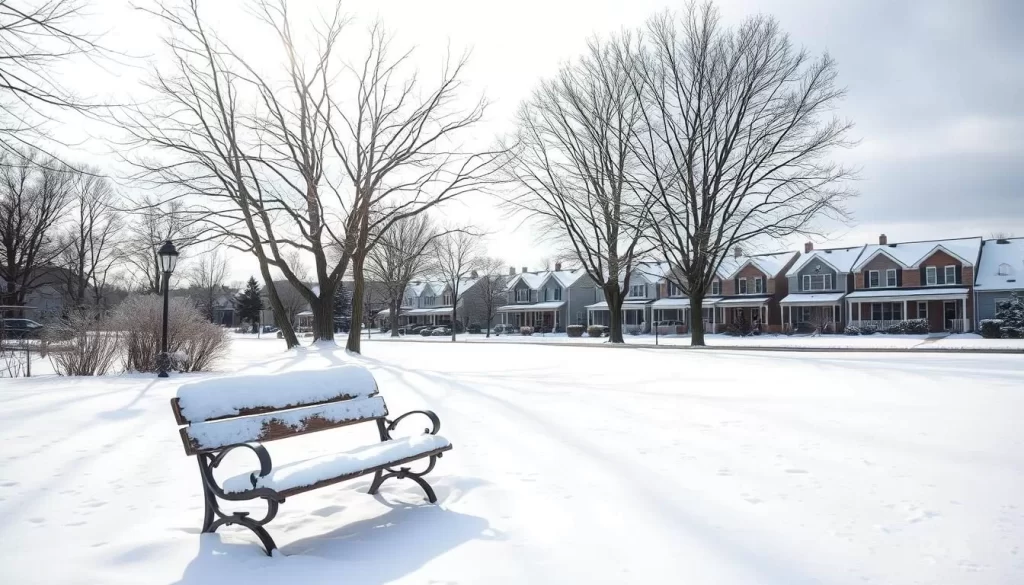
Spring in New Jersey: Renewal and Unpredictability
Spring in New Jersey is a season of renewal, marked by unpredictable weather patterns. As the state transitions from winter to spring, you’ll witness a gradual warming of temperatures and the emergence of vibrant blooms.
March Through May: Warming Trends and Blooms
During the spring months (March through May), New Jersey experiences a mix of chilly and warm days. In April, for instance, Newark starts to warm up, with temperatures ranging from 50 to 70 degrees F. Places farther from the shore tend to be warmer during this season. You’ll see signs of spring like blooming flowers and new leaves, including yellow daffodils, multi-hued tulips, and pink cherry blossom trees.
Spring Outdoor Opportunities
Spring provides excellent opportunities for outdoor activities such as hiking, bird watching, and garden tours. As nature awakens from its winter slumber, the state’s parks and gardens become ideal destinations for those looking to enjoy the beauty of the season. With the unpredictable weather in mind, it’s essential to be prepared for spring rain showers.
Packing for Unpredictable Spring Weather
When packing for spring in New Jersey, consider including layers and light jackets that can adapt to changing conditions. Mornings and evenings can be significantly cooler than mid-day temperatures, so it’s crucial to be prepared. Here’s a simple guide to help you pack:
| Item | Reason |
|---|---|
| Light jackets | For cooler mornings and evenings |
| Rain gear | To prepare for spring rain showers |
| Comfortable shoes | For hiking and outdoor activities |
New Jersey, United States: Best Months for a Weather-Savvy Trip
To make the most of your trip to New Jersey, consider the optimal weather conditions. The state’s climate varies significantly throughout the year, making some months more suitable for certain activities than others.
Optimal Weather Windows: April-May and September-October
The best times to visit New Jersey for ideal weather are during the shoulder seasons. April and May offer warming temperatures and blooming landscapes, while September and October provide mild weather and colorful foliage. These periods typically have comfortable temperatures, lower humidity, and fewer crowds compared to the peak summer months.

Balancing Weather Preferences with Activity Plans
When planning your trip, it’s essential to balance your weather preferences with your desired activities. If you’re looking for beach activities, late June through early September offers the warmest ocean temperatures. However, for outdoor exploration of parks, gardens, and hiking trails, the milder temperatures of spring and fall are more comfortable. Weather-savvy travelers often prefer these shoulder seasons for the best combination of pleasant conditions and reduced tourist congestion.
Monthly Weather Breakdown: Temperature and Precipitation
To plan your trip effectively, it’s vital to know the average monthly temperatures and precipitation patterns in New Jersey. This knowledge will help you pack accordingly and make the most of your visit.
Average Monthly Temperatures
New Jersey experiences significant temperature variations throughout the year. In the winter months (December to February), average high temperatures range between 29-37°F, with overnight lows often dropping below freezing. In contrast, summer months (June to August) bring average high temperatures in the 80s°F, with July typically being the warmest month, sometimes exceeding 90°F. Understanding these temperature fluctuations will help you prepare for your visit.
Rainfall and Snow Patterns Throughout the Year
Rainfall is distributed fairly evenly throughout the year in New Jersey, with slightly higher precipitation during the summer months, particularly in July, which sees about 4.39 inches of rain. Snow is most common from December through March, with January and February typically receiving the highest snowfall amounts, especially in the northern parts of the state. It’s essential to be prepared for these weather conditions by bringing a light raincoat or umbrella, regardless of the time of year you visit.
Regional Weather Variations Across New Jersey
When visiting New Jersey, understanding the regional weather variations is crucial. The state’s diverse geography leads to different climate conditions in various areas.
Atlantic Coast Climate Patterns
The Jersey Shore area enjoys slightly warmer temperatures than the inland areas due to its coastal location. Coastal areas benefit from cooling sea breezes during summer months, making temperatures feel more comfortable than in inland locations with the same readings. The ocean waters also moderate extreme temperature swings, resulting in milder winters compared to the rest of the state.
- The Atlantic coast experiences different weather patterns than the northern and central parts of New Jersey.
- The moderating effect of the ocean leads to relatively milder winters along the Jersey Shore.

Northern and Central New Jersey Weather
Northern New Jersey, particularly the highlands region, experiences colder temperatures and more significant snowfall than southern and coastal areas. Central New Jersey serves as a transition zone between the coastal and northern climate patterns, often experiencing elements of both. This regional variation allows you to potentially “climate shop” within the state, choosing areas with weather conditions that best match your preferences.
- Northern New Jersey’s weather is characterized by colder temperatures and heavier snowfall.
- Central New Jersey’s climate is a mix of coastal and northern weather patterns.
Planning Around Peak Tourist Seasons
When planning your trip to New Jersey, understanding the peak tourist seasons is crucial for a smooth experience. The state’s popularity as a tourist destination means that certain times of the year are busier than others.
Summer Crowds: What to Expect
Summer, particularly July and August, is the peak tourist season in New Jersey, especially at the Jersey Shore. During this time, you can expect larger crowds, higher prices, and the need to book accommodations well in advance. Summer weekends at popular shore destinations often require minimum stay requirements and significantly higher rates than weekdays or off-season periods.
Off-Season Benefits and Considerations
Visiting during the shoulder seasons of late spring and early fall offers significant benefits, including lower prices, fewer crowds, and more availability, while still enjoying pleasant weather. If you prefer to visit during the off-season (November through March), you can expect the lowest prices and greatest availability, though some shore businesses may be closed or operate on reduced hours.
Weather-Based Activities in New Jersey
You can enjoy a wide array of weather-based activities in New Jersey, making it a great destination any time of the year. The state’s diverse climate allows for a range of experiences across different seasons.
Outdoor Recreation by Season
In the summer, enjoy beach days along the Jersey Shore, water sports on the lakes and rivers, and outdoor dining. During fall, take advantage of the mild weather to hike through state parks and visit farms for apple and pumpkin picking. In spring, explore the state’s parks as flowers bloom and temperatures warm, ideal for garden tours and bird watching.

Indoor Attractions for Inclement Weather
On a rainy day or during winter, New Jersey offers numerous indoor attractions. Visit world-class museums, historic sites, shopping malls, and entertainment venues. If you’re into snow, you can find skiing and snowboarding resorts in the northern part of the state. Having a mix of indoor and outdoor activities planned ensures you’ll have a great experience regardless of the weather.
Weather-Related Events and Festivals Worth Planning For
The Garden State offers a plethora of weather-related events and festivals that are worth planning your trip around. New Jersey’s diverse climate allows for a wide range of seasonal celebrations that showcase the best of each time of year.
Seasonal Celebrations Across the State
New Jersey’s events calendar is filled with activities that cater to all seasons. In the spring, you can enjoy the Garden State Film Festival in Asbury Park or the Cape May Strawberry Festival, celebrating the strawberry season. Summer brings numerous beach concerts and outdoor celebrations, including the spectacular Atlantic City Airshow in August, attracting nearly a million spectators.
As fall arrives, the state features harvest festivals, wine tastings, and Halloween events, celebrating the season’s bounty and colorful landscapes. Winter offers holiday markets, New Year’s celebrations, and unique events like the Polar Bear Plunge in Seaside Heights on January 1st.
| Season | Events | Locations |
|---|---|---|
| Spring | Garden State Film Festival, Cape May Strawberry Festival | Asbury Park, Cape May |
| Summer | Atlantic City Airshow, Night in Venice | Atlantic City, Ocean City |
| Fall | Harvest Festivals, Wine Tastings | Various Locations |
| Winter | Polar Bear Plunge, Holiday Markets | Seaside Heights, Various Locations |
Weather-Dependent Annual Events
Many of these seasonal celebrations are weather-dependent, so it’s advisable to check event schedules and have flexible plans. By aligning your visit with these special events, you’ll experience New Jersey’s cultural traditions while enjoying the seasonal weather conditions they’re designed to celebrate. For instance, the Atlantic City Airshow is a summer highlight that you wouldn’t want to miss, while the Cape May Strawberry Festival is a spring treat.
Conclusion
With a grasp of New Jersey’s seasonal weather, you can tailor your visit to enjoy the best activities the state has to offer. You now have a comprehensive understanding of the state’s weather patterns, which will help you plan a weather-savvy trip to the Garden State.
The best times to visit New Jersey are during the shoulder seasons: late April through May and September through October. These periods offer pleasant temperatures and fewer crowds, making your travel experience more enjoyable.
By understanding New Jersey’s weather, you’ll be able to maximize your enjoyment of the state’s many outdoor and indoor attractions, whether you’re visiting for a weekend getaway or an extended vacation. You’re now ready to plan your perfect visit to New Jersey, United States.
The above is subject to change.
Check back often to TRAVEL.COM for the latest travel tips and deals.
Here are some Tours & Sightseeing suggestions that might pique your interests!
